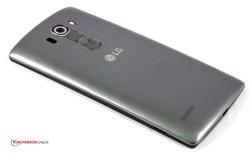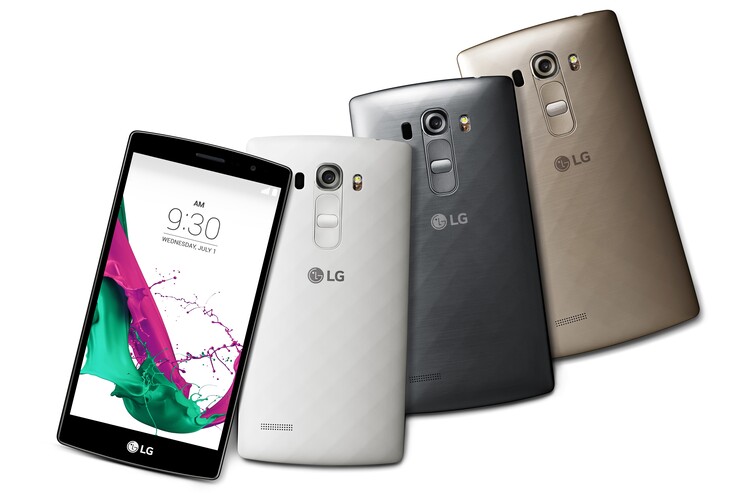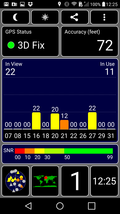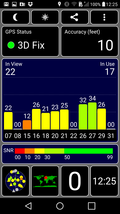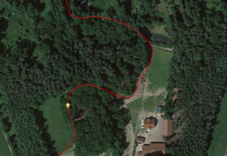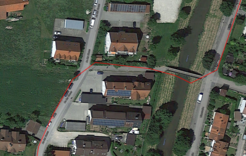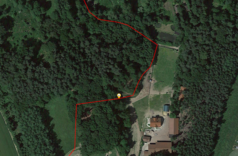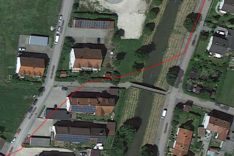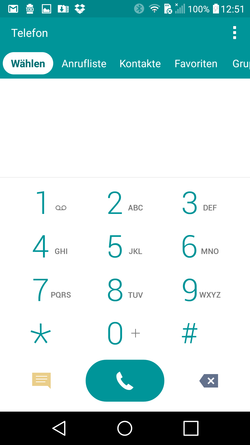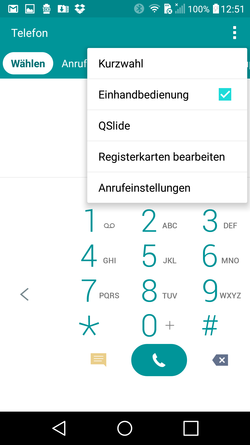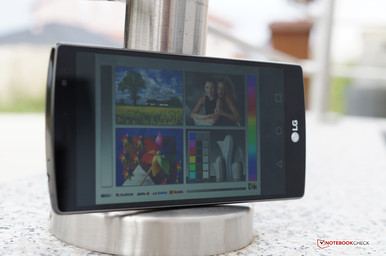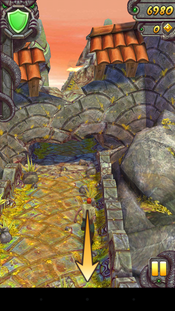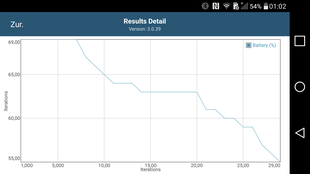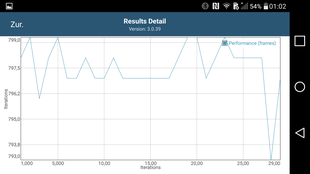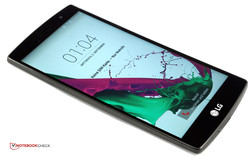LG G4s Smartphone Review
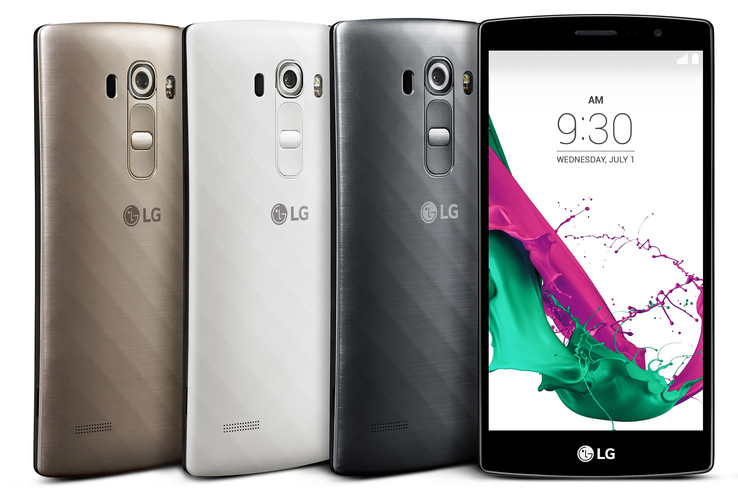
For the original German review, see here.
LG currently introduces a new smartphone sibling of its flagship model G4 every couple of weeks. After the recently reviewed G4c, a much less powerful and more compact version, the South Koreans now launch the G4s. The size is a bit bigger than the G4c, and LG also pumped up the features a bit. The price of the G4s is also between the two siblings. LG charges 400 Euros (~$452) for the 5.2-inch Android smartphone. It takes the design from the top model with the curved surfaces and parts of the camera equipment, where the G4 set the bar pretty high. The computing is handled by a modern octa-core from Qualcomm. The resolution of the IPS display is Full HD. This means the G4s clearly wants to be an upper mainstream device, and our review will show if this is a success. Rivals are other upper mainstream devices, which includes the similarly expensive yet much more powerful OnePlus 2, the much cheaper ZTE Blade V6 as well as the similarly equipped Sony Xperia M4 Aqua.
Case
We cannot say a lot about the case of the LG G4s that we haven’t said in the review of the LG G4c. Without the optional leather cover, the haptics is not even close to the flagship G4, but there is still not a lot of criticism for the build quality or the stability. The back cover in an aluminum look can be removed and grants access to the replaceable battery, the SIM slot and the microSD slot. The slight diamond pattern also looks good, but the cover is not really scratch-resistant. The horizontal and vertical curvature also looks very good on the G4s and complements the good feeling when you hold it in your hand.
Both the dimensions and the weight of the G4s are right between its two siblings. A height of 9.9 millimeters is close to the G4, but not really thin due to the curved design. Length (142.7 mm) and width (72.6) are pretty compact, despite the 5.2-inch display. The weight is also comparatively low at 140 grams. Right now, the G4s is available in Metallic Grey and Ceramic White. A leather cover, similar to the bigger sibling, would definitely add a level of sophistication, but it will be probably reserved for the G4.
Connectivity
The technical specifications of the LG G4s are also right between its two siblings. Calculations are handled by a pretty modern octa-core processor. Qualcomm’s Snapdragon 615 was announced in February 2014 and is one of the first chips from the manufacturer with 64-bit support. It consists of eight Cortex-A53 cores that are clocked at up to 1.5 GHz in the LG G4s, while the reference design is clocked at 1.7 GHz. The SoC also includes the GPU Adreno 405 from the same manufacturer. Its Boost clock is 550 MHz. The Adreno 405 is an upper mainstream chip and should also be sufficient for all challenges in 2015 – including Full HD. The SoC is supported by 1.5 GB memory, which does not really suit the high-end claim.
This is also the case for the internal storage at just 8 GB, and you can only use 3.2 GB ex-works. A storage expansion is therefore pretty much a necessity. The G4s has a microSD slot that can be equipped with memory cards at up to 128 GB. Thanks to the support of apps like App2SD, it is also possible to transfer some apps to the SD card; but, unfortunately, it did not work with all apps, so the small internal storage can be a problem.
The USB 2.0 port at the bottom of the smartphone supports OTG and Slim-Port. This means it is possible to transfer HD content to the HDMI port of an external display with the corresponding adapter cable.
Software
Operating system of the LG G4s is Google’s Android 5.1.1, which is currently the latest version. This means the G4s also has an advantage over its two siblings, although they are also running Lollipop as well. LG’s own user interface LG UX 4.0 is obviously once again included, too. Except for the different OS version, the software equipment of our review unit does not differ from the LG G4c, so we recommend the review of the LG G4c for more information.
Communication & GPS
There is no difference between the review unit and the smaller sibling G4c in respect of the wireless modules, either. Similar to the G4c, the G4s supports LTE Cat. 4 with transfer rates of up to 150 Mbps (downstream) and 50 Mbps (upstream) or 42 and 5.76 Mbps, respectively via UMTS. Absolutely up to date is the Wi-Fi module that supports the fast ac standard. The G4s can also use 5 GHz ac networks, but only 2.4 GHz networks for the standards 802.11 b/g/n – we cannot understand this decision. The range of the Wi-Fi signal, however, is very good, and the connection was stable even at a distance of 10 meters to the router and through two walls. Bluetooth 4.1 is available as well and has advantages when you use LTE in particular, because there will be less interferences compared to older Bluetooth standards.
The integrated A-GPS module finds a sufficient number of satellites within a couple of seconds outdoors. A satellite fix is even possible indoors when you are close to a window, where it takes around 30 seconds for the first location. We check the accuracy of the GPS sensor with a bicycle ride and compare it with a Garmin Edge 500 reference device. This device is specialized for bicycle rides and proved to be very accurate and reliable over the years. The test shows that the LG G4s likes to take the direct way instead of the actual turn. We pretty much hover across the river at the bridge section and do not even touch the bridge at all. All in all, the LG misses around 4% of the track, which is completely sufficient for the navigation with the car or the bicycle. But you might take the occasional wrong turn on narrow single trails.
Telephone & Voice Quality
The phone app does not differ from the other G4 siblings. The interface follows the LG style and leaves a fresh as well as simple impression. It supports handy features like contact groups as well as a one-hand mode. The handling is intuitive and should not be a problem for any user.
The voice of the caller was always perfectly audible via the earpiece and sounded very natural and clear. Our voice was not always that good on the other side since it was often accompanied by some background noise. Our voice also sounded a bit synthetic, which is probably a result of the ambient noise suppression that works pretty well. The hands-free function via internal speaker only works well in calm environments. The provided entry-level headset works a bit better, but it is not a real joy to make calls with it, either.
Cameras & Multimedia
The "mother" of the G4 family, the LG G4, is currently certainly one of the best camera smartphones on the market. The G4c could not really keep up with that performance, but the G4s gets some of the great features from the top model including the color spectrum sensor, the laser autofocus and the image stabilizer. The resolution of the G4s, however, is lower than the G4, but five megapixels at the front and eight for the main camera of the G4s are still decent. Both cameras can record Full HD videos.
The quality of the pictures is decent: Colors look vivid, and the sharpness is conveniently high as well. You can only notice the lower resolution when you zoom in. Bright areas are slightly overexposed by the sensor, whereas the illumination is slightly insufficient in darker situations. All in all, the G4s is once again between its siblings, but there is still a respectable distance to the flagship G4.
Accessories
The box of the LG G4s includes a stereo in-ear headset with microphone and control element besides the usual stuff like a power adaptor, USB cable and a quick-start guide. The quality of the headset, however, is not very good, and it is certainly only a temporary replacement for a better product.
Warranty
LG grants a warranty of 24 months for the smartphone, but the accessories and the battery are only covered for six months.
Input Devices & Handling
Similar to the two G4 siblings, we did not have any issues with the capacitive touchscreen. It is precise up into the peripheral areas and executes inputs without a noticeable delay. The fingers can glide across the surface made of scratch-proof Corning Gorilla Glass 4 very conveniently and without a disturbing resistance. The control elements of the latest LG smartphone are obviously at the back once again. The handling works pretty well once you get used to the location, especially since the G4s can also be activated from standby via double tap on the display.
The virtual keyboard allows quick typing and also includes a permanent additional row with numbers. However, you cannot really see anything from the actual display content in landscape mode. You can easily split the keyboard with your fingers, which is very convenient.
The processor performance of the LG G4s is sufficient to ensure a smooth handling in every situation. At least we could not notice annoying stutters or even short periods where the picture froze.
Display
The display technology of the LG G4s has more in common with the smaller sibling G4c than the flagship. The latest member of the family uses a "normal" IPS panel instead of the quantum version from the G4. The Full HD resolution, however, is once again right between the two siblings and manages a comparatively high pixel density at 423 PPI.
Our measurement results show that the G4s is the worst member of the G4 family. A maximum luminance of 414 cd/m² is certainly not bad and completely sufficient for most scenarios, but both siblings show that it could be much brighter. The two rivals OnePlus 2 and Sony Xperia M2 Aqua have much brighter panels as well. The black value is much better in comparison – 0.38 cd/m² does not only surpass the two siblings, but the rival from Sony falls behind as well. Only the OnePlus 2 manages a better result. It also reaches a much higher contrast ratio, even though there is no criticism for the 1,082:1 of the G4s. The brightness distribution of 88%, however, is just average. The brightness drops at the upper right corner in particular, but the difference is still not visible to the human eye.
| |||||||||||||||||||||||||
Brightness Distribution: 88 %
Center on Battery: 411 cd/m²
Contrast: 1082:1 (Black: 0.38 cd/m²)
ΔE ColorChecker Calman: 5.3 | ∀{0.5-29.43 Ø4.77}
ΔE Greyscale Calman: 6.32 | ∀{0.09-98 Ø5}
96% sRGB (Argyll 1.6.3 3D)
71% AdobeRGB 1998 (Argyll 1.6.3 3D)
Gamma: 2.37
CCT: 7250 K
| LG G4s Adreno 405, 615 MSM8939, 8 GB eMMC Flash | OnePlus 2 Adreno 430, 810 MSM8994, 64 GB eMMC Flash | ZTE Blade V6 Mali-T720 MP2, MT6735, 16 GB eMMC Flash | Sony Xperia M4 Aqua Adreno 405, 615 MSM8939, 8 GB eMMC Flash | |
|---|---|---|---|---|
| Screen | 14% | -21% | -8% | |
| Brightness middle (cd/m²) | 411 | 451 10% | 336 -18% | 547 33% |
| Brightness (cd/m²) | 392 | 446 14% | 315 -20% | 535 36% |
| Brightness Distribution (%) | 88 | 90 2% | 81 -8% | 92 5% |
| Black Level * (cd/m²) | 0.38 | 0.3 21% | 0.39 -3% | 0.81 -113% |
| Contrast (:1) | 1082 | 1503 39% | 862 -20% | 675 -38% |
| Colorchecker dE 2000 * | 5.3 | 3.84 28% | 8.29 -56% | 5.77 -9% |
| Greyscale dE 2000 * | 6.32 | 3.97 37% | 8.57 -36% | 5.87 7% |
| Gamma | 2.37 93% | 2.46 89% | 1.96 112% | 2.14 103% |
| CCT | 7250 90% | 7283 89% | 8172 80% | 7784 84% |
| Color Space (Percent of AdobeRGB 1998) (%) | 71 | 58.07 -18% | 72.0875 2% | |
| Color Space (Percent of sRGB) (%) | 96 | 90.14 -6% | 89.7 -7% | 96.5753 1% |
* ... smaller is better
Subjectively, we are pretty happy with the picture quality of the LG G4s. The high pixel density ensures a sharp presentation even with fine structures, and the low black value ensures that black content looks very rich. Pictures and videos in particular benefit from the high contrast ratio.
The colorimeter in combination with the CalMAN software still shows some weaknesses. Bright shades of gray have a slight tendency towards cyan and the color temperature is too low as well. The primary colors, however, are very close to their ideal values, and the average DeltaE deviation of 5.3 for the ColorChecker is decent as well. Medium saturation areas in particular are a problem in the saturation sweeps, but the overall performance of the G4s in the display section is still pretty good, and it can even beat its siblings in terms of color representation.
The LG G4s cannot quite match the luminance of its two siblings, which is mainly noticeable outdoors. It is still no problem to see the display content if you avoid direct sunlight, but you will miss a brighter picture on really bright summer days, especially due to the glossy screen. This is, however, a common issue for almost every smartphone. The viewing-angle stability is convincing. The picture will only be slightly darker with a lower contrast from very flat angles, but this does not affect the good picture quality.
Performance
Similar to the other G4 models, LG once again decided to use an SoC from Qualcomm. The performance of the Snapdragon 615 MSM8939 is pretty much right between the 808 in the G4 and the 410 in the G4c. It consists of eight Cortex-A53 cores, where four cores can run at up to 1.5 GHz and the other ones at up to 1.0 GHz. This is supposed to realize both a high performance as well as long battery runtimes. Still, the performance should only be slightly higher compared to a similarly clocked quad-core. The GPU Adreno 405 is a good choice for the LG G4s and should not have any problems with titles from 2015. LG could have been more generous in terms of memory though. We think 2 GB instead of the installed 1.5 GB would have been better for the concept, especially since it would have been right in the middle between the G4 and G4c.
This is also exactly the position of the G4s in the benchmarks. All system tests see the G4s clearly behind its flagship sibling G4, but at the same time clearly ahead of the compact G4c. Within our comparison group, the similarly equipped OnePlus 2 has an uncatchable lead, but the LG G4s usually beats the rivals from ZTE and Sony, which are similarly powerful on paper. This means the performance of the LG G4s is convenient.
| Geekbench 3 | |
| 32 Bit Single-Core Score (sort by value) | |
| LG G4s | |
| LG G4 | |
| LG G4c | |
| OnePlus 2 | |
| ZTE Blade V6 | |
| Sony Xperia M4 Aqua | |
| 32 Bit Multi-Core Score (sort by value) | |
| LG G4s | |
| LG G4 | |
| LG G4c | |
| OnePlus 2 | |
| ZTE Blade V6 | |
| Sony Xperia M4 Aqua | |
| AnTuTu v5 - Total Score (sort by value) | |
| LG G4s | |
| LG G4 | |
| LG G4c | |
| OnePlus 2 | |
| ZTE Blade V6 | |
| Sony Xperia M4 Aqua | |
| 3DMark - 1280x720 offscreen Ice Storm Unlimited Score (sort by value) | |
| LG G4s | |
| LG G4 | |
| LG G4c | |
| OnePlus 2 | |
| ZTE Blade V6 | |
| Sony Xperia M4 Aqua | |
| GFXBench 3.0 | |
| 1920x1080 1080p Manhattan Offscreen (sort by value) | |
| LG G4s | |
| LG G4 | |
| LG G4c | |
| OnePlus 2 | |
| ZTE Blade V6 | |
| Sony Xperia M4 Aqua | |
| on screen Manhattan Onscreen OGL (sort by value) | |
| LG G4s | |
| LG G4 | |
| LG G4c | |
| OnePlus 2 | |
| ZTE Blade V6 | |
| Sony Xperia M4 Aqua | |
| PCMark for Android - Work performance score (sort by value) | |
| LG G4s | |
| LG G4 | |
| LG G4c | |
| OnePlus 2 | |
| Sony Xperia M4 Aqua | |
| Smartbench 2012 | |
| Productivity Index (sort by value) | |
| LG G4s | |
| LG G4 | |
| LG G4c | |
| OnePlus 2 | |
| ZTE Blade V6 | |
| Sony Xperia M4 Aqua | |
| Gaming Index (sort by value) | |
| LG G4s | |
| LG G4 | |
| LG G4c | |
| OnePlus 2 | |
| ZTE Blade V6 | |
| Sony Xperia M4 Aqua | |
This is also the case for the web performance, where the G4s is once again clearly behind the flagship devices G4 and OnePlus 2, but the other comparison devices are more or less clearly beaten. The subjective browsing experience supports the benchmarks results.
| Octane V2 - Total Score (sort by value) | |
| LG G4s | |
| LG G4 | |
| LG G4c | |
| OnePlus 2 | |
| ZTE Blade V6 | |
| Sony Xperia M4 Aqua | |
| Browsermark - 2.1 (sort by value) | |
| LG G4s | |
| LG G4 | |
| OnePlus 2 | |
| Sunspider - 1.0 Total Score (sort by value) | |
| LG G4s | |
| LG G4 | |
| LG G4c | |
| OnePlus 2 | |
| ZTE Blade V6 | |
| Sony Xperia M4 Aqua | |
| Mozilla Kraken 1.1 - Total (sort by value) | |
| LG G4s | |
| LG G4 | |
| LG G4c | |
| OnePlus 2 | |
| ZTE Blade V6 | |
| Sony Xperia M4 Aqua | |
| WebXPRT 2015 - Overall (sort by value) | |
| LG G4s | |
| LG G4 | |
| LG G4c | |
| OnePlus 2 | |
| Sony Xperia M4 Aqua | |
* ... smaller is better
The situation changes a bit when we evaluate the performance of the internal storage. The LG G4s once again follows the internal hierarchy. The comparison devices from the other manufacturers, however, are faster than the review unit. All in all, the results are satisfactory, no more and no less.
| AndroBench 3-5 | |
| Random Write 4KB (sort by value) | |
| LG G4s | |
| LG G4 | |
| LG G4c | |
| OnePlus 2 | |
| ZTE Blade V6 | |
| Sony Xperia M4 Aqua | |
| Random Read 4KB (sort by value) | |
| LG G4s | |
| LG G4 | |
| LG G4c | |
| OnePlus 2 | |
| ZTE Blade V6 | |
| Sony Xperia M4 Aqua | |
| Sequential Write 256KB (sort by value) | |
| LG G4s | |
| LG G4 | |
| LG G4c | |
| OnePlus 2 | |
| ZTE Blade V6 | |
| Sony Xperia M4 Aqua | |
| Sequential Read 256KB (sort by value) | |
| LG G4s | |
| LG G4 | |
| LG G4c | |
| OnePlus 2 | |
| ZTE Blade V6 | |
| Sony Xperia M4 Aqua | |
Games
Qualcomm's Adreno 405 is certainly not a high-end GPU. The expected performance is roughly on par with the slightly older Adreno 320, which was once the most powerful GPU from the manufacturer. Still, the Adreno 405 has no problems with current 3D titles. Games like Modern Combat 5 or Asphalt 8 run smoothly at the highest settings. Simpler titles like Angry Birds 2 or Temple Run 2 are therefore obviously no challenge for the GPU.
Gaming on the LG G4s was a very enjoyable experience because the position sensor worked well but was not too sensitive, and the touchscreen has good gliding capabilities.
Emissions
Temperature
The LG G4s is already noticeably warm while idling. All the measured temperatures are still okay, but up to 35.2 °C while idling surpasses the average result. We can see another increase under load, but many other smartphones are warmer in this scenario. Up to 40.1 °C for the G4s is actually quite cool. The temperatures of the power adaptor are not critical, either.
This also applies for the behavior of the LG G4 s in the GFXBench 3.0 Battery Test. It repeats the T-Rex test thirty times and protocols the temperatures, the performance as well as the clocks. Both the performance and the clocks fluctuate right away, but this does not really affect the overall performance. We can only see a performance drop in the last run, but it will immediately recover. Throttling is therefore hardly a problem for the G4s.
You should, however, consider that the G4s – similar to its siblings – dims the brightness quite early when the temperatures of the components are getting higher. This is annoying and should finally be stopped by the manufacturer.
(±) The maximum temperature on the upper side is 40.1 °C / 104 F, compared to the average of 35.2 °C / 95 F, ranging from 21.9 to 247 °C for the class Smartphone.
(+) The bottom heats up to a maximum of 39 °C / 102 F, compared to the average of 34 °C / 93 F
(±) In idle usage, the average temperature for the upper side is 32.7 °C / 91 F, compared to the device average of 32.9 °C / 91 F.
Speakers
Similar to its siblings, the position of the mono speaker of the LG G4s is pretty unfavorable at the lower part of the back, so it is often covered by the hand. This is unfortunate, since the sound of the small module is quite good. The performance of the G4s is once again between its siblings G4 and G4c. The latest device from LG obviously also lacks dynamics and power, especially in the deep range. The maximum volume, however, is conveniently high and there are no annoying distortions. It is certainly sufficient for games or video playback.
Energy Management
Power Consumption
At just 8.9 Wh, the battery capacity of the LG G4s (lithium-ion) is lower than its smaller sibling G4c. In combination with the more powerful processor, we can only expect shorter battery runtimes compared to the G4c. Another factor is that the G4s already consumes quite a lot of power at the minimum brightness. The review unit is not very frugal under maximum load, either.
| Off / Standby | |
| Idle | |
| Load |
|
Key:
min: | |
Battery Runtime
We can see the negative effects on the stamina, because the determined runtimes are even worse than expected. All the comparison devices manage much longer runtimes in all scenarios, and the two siblings perform better as well. Particularly disappointing is the result in the Wi-Fi test at a display brightness of 150 cd/m², where the G4s only lasts four-and-a-half hours. Another uninspiring, but at least better result is the runtime of seven hours during video playback. The G4s probably won’t last a full day – a secondary battery might not be a bad idea.
| LG G4s Adreno 405, 615 MSM8939, 8 GB eMMC Flash | OnePlus 2 Adreno 430, 810 MSM8994, 64 GB eMMC Flash | ZTE Blade V6 Mali-T720 MP2, MT6735, 16 GB eMMC Flash | Sony Xperia M4 Aqua Adreno 405, 615 MSM8939, 8 GB eMMC Flash | |
|---|---|---|---|---|
| Battery runtime | 34% | 28% | 36% | |
| H.264 (h) | 7 | 9.7 39% | 7.1 1% | 8.6 23% |
| WiFi v1.3 (h) | 4.6 | 5.9 28% | 6.7 46% | 7 52% |
| Load (h) | 2.8 | 3.8 36% | 3.8 36% | 3.7 32% |
Pros
Cons
Verdict
LG further expands its lineup around the current flagship G4 and the G4s is already the second sibling. Contrary to the G4c it is not a radically slimmed-down version, but still a powerful upper mainstream version with the corresponding specs. The Snapdragon 615 provides sufficient performance, and even current games are no problem for the SoC. The memory is a bit meager at just 1.5 GB and does not really suit the premium claim. The IPS display is pretty good in general, but a slightly higher luminance would have been nice – especially when you look at the two siblings.
This can also be said about the case, because there is not much criticism. Still, the leather cover of the top model is pretty appealing and would also improve the tactile impression of the G4s – we would also take it as an optional accessory. It is no surprise that the camera of the top model G4 is out of reach, but you can also take nice pictures with the G4s. Only the lighting should be sufficient. The speaker is no highlight, but the sound is actually decent. There is also not much criticism for the features. So, is it a great offer?
Not without restrictions: Probably the biggest issue of the otherwise really convenient LG G4s is its poor stamina. The combination of the rather small battery and the high consumption even results in bad idle runtimes. It is good that the battery can be replaced, because it is pretty much a necessity. We would have also liked to see dual-band Wi-Fi and a slightly more precise GPS module.
LG does a pretty good job with the G4s and can copy a lot of the glamour from the top model into the less expensive upper mainstream segment. The poor battery runtimes, however, affect the good impression significantly.
LG G4s
- 09/08/2015 v4 (old)
Patrick Afschar Kaboli


